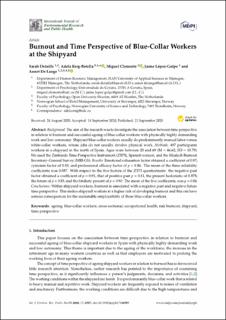Burnout and Time Perspective of Blue-Collar Workers at the Shipyard
Peer reviewed, Journal article
Published version

View/
Date
2020Metadata
Show full item recordCollections
Original version
Detaille, S., Reig-Botella, A., Clemente, M., López-Golpe, J., & De Lange, A. (2020). Burnout and time perspective of blue-collar workers at the shipyard. International Journal of Environmental Research and Public Health, 17(18), 6905. 10.3390/ijerph17186905Abstract
Background: The aim of the research was to investigate the association between time perspective in relation to burnout and successful ageing of blue-collar workers with physically highly demanding work and low autonomy. Shipyard blue-collar workers usually do predominantly manual labor versus white-collar workers, whose jobs do not usually involve physical work. Methods: 497 participants workers in a shipyard in the north of Spain. Ages were between 20 and 69 (M = 46.62, SD = 10.79). We used the Zimbardo Time Perspective Instrument (ZTPI), Spanish version, and the Maslach Burnout Inventory–General Survey (MBI-GS). Results: Emotional exhaustion factor obtained a coefficient of 0.97; cynicism factor of 0.83; and professional efficacy factor of p = 0.86. The mean of the three reliability coefficients was 0.887. With respect to the five factors of the ZTPI questionnaire: the negative past factor obtained a coefficient of p = 0.91; that of positive past p = 0.81; the present hedonistic of 0.878; the future of p = 0.83; and the fatalistic present of p = 0.90. The mean of the five coefficients, was p = 0.86. Conclusions: Within shipyard workers, burnout is associated with a negative past and negative future time perspective. This makes shipyard workers at a higher risk of developing burnout and this can have serious consequences for the sustainable employability of these blue-collar workers.
